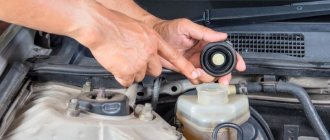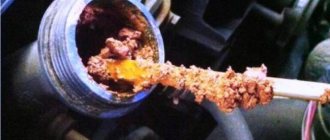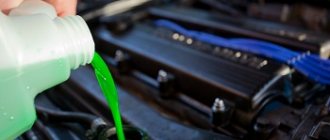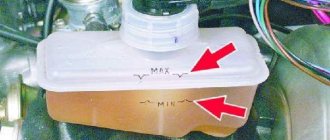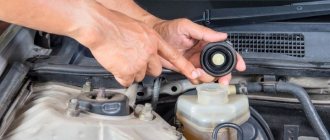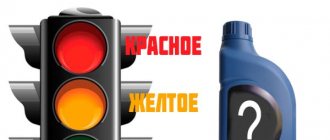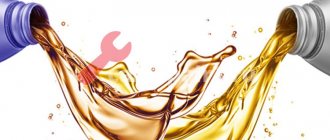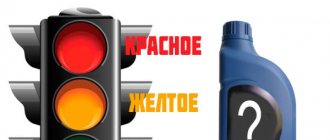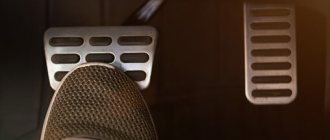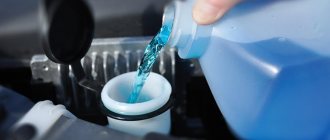Differences between antifreeze and antifreeze.
Today, three types of coolants for internal combustion engines are used: water (distilled or pure rainwater), antifreeze and antifreeze.
Antifreeze is the name of the liquid (translated as “anti-freeze”) for the engine cooling system, which does not freeze and can withstand high temperatures.
Standard composition of antifreeze for cars:
- Water.
- Ethylene glycol.
- Glycerol.
- Alcohol.
- Acid salts or carbonate additives.
Composition of antifreeze:
- Water.
- Anti-corrosion additives.
- Burates and phosphates.
- Alcohols.
- Glycols.
- Nitrites.
- Silicates.
- Nitrates.
Differences:
- antifreeze was invented later than antifreeze;
- Antifreeze is better in terms of environmental friendliness;
- The boiling point of antifreeze is higher;
- The freezing point of antifreeze is lower;
- Antifreeze provides better protection against corrosion.
- Antifreeze forms a protective film, but antifreeze does not, and therefore antifreeze cools much more efficiently.
- The service life for which antifreeze is designed is 6 times less than that of antifreeze.
- antifreeze protects engine cylinder liners from cavitation (air bubbles).
- The service life of the pump (pump) is significantly reduced if antifreeze is used.
- antifreeze does not clog radiators, and various types of deposits do not form.
The main disadvantage of antifreeze is that when heated to 105 degrees, its properties deteriorate.
Antifreeze boils when heated to 115 degrees and does not leave sediment in the channels and can be used for up to 250,000 km.
In which cars should I use antifreeze, and where should I use antifreeze?
Against the background of the considered features of different types of coolants, the question arises of what is recommended to be used and in what case.
The first thing you should focus on when choosing is the make of the car and the manufacturer’s recommendations. The developers specify in the vehicle manual which consumables are best to use.
But these are only recommendations. In practice, the car enthusiast takes responsibility for the choice onto his own shoulders.
So which is better? Please note the following points:
- Antifreeze can be used on old domestic cars of the VAZ, Moskvich and other brands. For foreign cars, high-quality antifreeze is more suitable (reasons are described below).
- The use of antifreeze leads to a decrease in power, increased fuel consumption and rapid engine wear.
- Antifreeze is more loyal to aluminum engine elements. If you use antifreeze in cars with a radiator made of this metal, you will soon need to purchase a new unit.
- When using antifreeze, the service life of the water pump is reduced, the radiator and thermostat become dirty faster.
- Antifreeze does not have a detrimental effect on the rubber and plastic elements of the cooling system, which cannot be said about its “competitor”.
Also read - Is it possible to mix antifreeze of different colors, brands and manufacturers in a car.
What happens if you mix antifreeze with antifreeze?
Firstly, the question is why mix these two different refrigerants. Well, various circumstances happen on the road, for example, there is an antifreeze leak and after eliminating the leak, you need to add antifreeze. But there is not always a canister of antifreeze in the trunk, and here they sell antifreeze nearby on the side of the road. You have to buy it and top it up to continue moving forward.
Or, as often happens, sooner or later after buying a used car, you have to top up the coolant, and then the driver asks the question: what was filled in before? Color is easy to determine, but classes are difficult. In such cases, experts recommend, again, not to save, but to drain the old fluid and fill in the new one in full. It is even possible that the old one has expired.
But, let's look at what happens after adding antifreeze to antifreeze.
From the composition we know that they only have in common water and, perhaps, a standard (ethyl alcohol). And each manufacturer adds different additives and additives in different quantities. Therefore, when mixing antifreeze and antifreeze, a sediment may form that will settle in the channels and on engine parts, which will gradually reduce the life of the internal combustion engine. Nothing bad will happen when adding antifreeze to antifreeze if their components are basically the same, but this cannot be checked with your own hands without a chemical laboratory.
Based on the above, we conclude that if you already had to mix antifreeze and antifreeze, then upon arrival, it is better to drain this liquid, do a complete flush of the engine cooling system and fill in a new homogeneous mixture. The cost of buying new antifreeze will save you a lot of money, effort and time.
Briefly about the engine cooling system
When choosing a flush for the engine lubrication system, additives for oil or diesel fuel, as well as when purchasing other technical fluids for a car, you must take into account the requirements and tolerances specified by the car manufacturer. Otherwise, the consequences can be very unpleasant. Equally important is the correct choice of coolant. There is an opinion that if you mix different antifreezes, you can harm the car. In this article we will help car owners understand this issue.
Manufacturers predominantly use liquid cooling systems in car designs. At first, the working fluid in them was ordinary water. The advantage of this solution was that water was easy to find even in extreme cases.
At the same time, this coolant option has a number of disadvantages:
- corrosion processes accelerate;
- Frequent flushing of the engine cooling system is required - in the case of using untreated water;
- water freezes when the air temperature drops below 0°C and boils quickly when heated;
- active vaporization and evaporation occurs;
- frequent engine breakdowns occur;
- constant monitoring of the cooling system is required;
- A large amount of sediment falls out (if untreated water is used).
Given the factors described here, automakers began to mix water used as coolant with glycerin and alcohol. Subsequently, the composition was constantly modernized. The result of this process was the appearance of antifreeze and antifreeze.
We recommend
“How to drain antifreeze completely and fill the system with new one: useful recommendations” Read more
Is it possible to mix different brands of antifreeze?
Let's start with what classes of antifreeze there are. This:
Antifreeze G11 is a liquid of inorganic origin and contains silicates. Available in blue or green colors. Suitable for old cars.
Antifreeze G12 is a liquid of organic origin. Produced in pink and red flowers.
Antifreeze g11 and g12 what is the difference
The difference between antifreeze g11 and g12 is that inorganic G11 contains substances that protect against corrosion (inhibitors). Thanks to corrosion inhibitors, a film is created on parts and protects it from contact with oxygen, which causes the metal to rust. Antifreeze GI 11 is glycol-based, that is, if you do not add corrosion inhibitors, the aggressive glycol will begin to corrode metal parts. OX G11 must be changed at least once every 2-3 years. The common color of JI-11 is green. Green G11 is the lowest class.
As for G12 class antifreezes, they are based on carbosilicates. Since many parts in an internal combustion engine are made of aluminum and steel, upon contact with liquids, destructive films are formed on their surfaces. The additives contained in GI 12 prevent the formation of a destructive film (the technology is called Long life). The substances in G12 do not form a protective film on all surfaces of channels and parts, but only where pockets of corrosion have appeared, in order to protect against further destruction of the metal. This class of antifreeze begins to boil at a temperature of 120 degrees. Service life 5 years.
Is it possible to mix antifreeze of different colors?
More often, antifreezes that have different colors also differ in characteristics. It's all about the additives used, which have their own shades. New brands of liquids differ from old auto chemicals in their environmental friendliness. On store shelves you can find hybrid, carboxylate, labrid and other formulations. Their difference is not only in colors, but also in composition, as well as performance characteristics.
As noted earlier, various additives give them their properties. It should be noted that mixing antifreezes of different shades, even if they are of the same type, but produced by different manufacturers, is extremely undesirable. The fact is that additives included in the liquid can react, which will lead to neutralization of their beneficial properties.
Let us remind you that mixing them is permissible only in very extreme cases. For example, G13 antifreeze poured into new cars can be combined with other liquids, but its anti-corrosion properties are significantly reduced. No matter what ratio G13 is mixed in, the resulting coolant will still be of significantly worse quality. That is, when combining G11 and 13, you get a liquid with the characteristics of the first antifreeze. In addition, prolonged use of the mixture can cause irreparable damage to the car.
Is it possible to mix antifreeze with water?
Since antifreeze contains a significant amount of water, if you add water to antifreeze, nothing bad will happen. Dilution simply occurs and concentration decreases. The more water you add, the worse the antifreeze properties will become.
But sometimes it is recommended to add water to antifreeze. This approach is used when antifreeze has boiled, causing water to evaporate and the remaining liquid in the cooling system to become highly concentrated. But when adding, you need to know the proportions. Excessive amounts of water will cause rust to appear in the cooling system.
Attention: mixing water with antifreeze is only possible in summer. At sub-zero temperatures, such diluted coolant can quickly seize and freeze.
If such antifreeze freezes, you will have to invest in repairs in the car components. Usually, when the coolant freezes, the radiator of the stove and engine ruptures, as well as pipes burst and hoses crack.
Even if the antifreeze was boiling and it became highly concentrated, it is better to add antifreeze of the same class and brand. In winter, it is safer to operate the car with high concentration antifreeze.
The conclusion about adding water to antifreeze is this: if you had to add water, then add a little.
When adding antifreeze, add only antifreeze of the same class that was added previously (G11, G12, G12+, G13) and the same color. Antifreeze class G-13 is based on propylene glycol.
Antifreeze classification
The most common are six brands of coolants. These include: antifreeze, G11, G12, G12+, G12++, G13. They are manufactured by different companies and may differ in color and concentration. It is important to note here that shades of antifreeze cannot act as a criterion when selecting a new one. Even with identical composition, coolant from different manufacturers may not match in color.
Differences between antifreezes of different classes:
- Antifreeze - produced in the USSR as a replacement for foreign coolants. Consists of distilled water and ethylene glycol with various additives. They come in green, blue and other colors.
- G11 is a classic antifreeze. The base composition includes ethylene glycol, water and additives (salts of certain acids, borates, nitrites, etc.). It has a long service life. Mostly blue.
- G12 – carboxylate antifreeze. The composition is similar to the previous one, but they additionally contain carboxylic acid compounds. They have a longer lifespan and are available in pink and red colors.
- G12+ is a mixture of water, ethylene glycol and additives (based on carboxylic, silicon, nitric and phosphoric acids). The components that make up such liquids may differ, depending on the manufacturer. Most often produced in red.
- G12++ also refers to hybrid antifreeze. For their production, an organic base and silicic acid compounds are used. The properties are similar to the previous type, and their main difference is their long service life. Available in red and sometimes yellow colors.
- G13 is a relatively new antifreeze. Its base, instead of ethylene glycol, is harmless propylene glycol. Colored in pink or purple shades.
Although the color of antifreeze serves more of a decorative function, it still has weight when choosing a liquid for the cooling system.
Antifreeze and water can be mixed
Antifreeze contains the same elements: water and ethylene glycol. Antifreeze was invented in the USSR in 1971.
Classification of antifreeze by type:
- A - ready to be poured into the car’s cooling system.
- M - modernized, that is, it contains additional components.
- K is a highly concentrated liquid, it will have to be diluted.
After the letters, which are divided by type, write 2 numbers - subzero temperature, at which the antifreeze will not freeze. For example, M40, or M65.
The color of good antifreeze is between blue and light blue; there is also a greenish color. Antifreeze brand A65 is red. Legal in Russia, GOST 28084-89 distributes three types of OZh-K, OZh-40, OZh-65. If there are no coolant (coolant) designations, there is only a GOST number, then it is a fake.
Composition of antifreeze
To understand whether it is possible to mix antifreeze of different brands, let’s look at its composition. The main substance of antifreeze is ethylene glycol, it has the chemical formula C2H6O2 and is a dihydric alcohol. In addition, antifreeze also contains other substances that have additional functions, these are various additives. They have lubricating and anti-foaming properties, and are also designed to protect the car’s cooling system from corrosion and oxidation.
In the lives of many motorists, unpleasant situations always await. For example, you purchased a car, but did not ask the former owner about the name of the antifreeze used in it, and at the most inopportune moment you discover that its level has decreased to critical. When you go to a car store, you see countless brands of antifreeze on display and wonder about the possibility of mixing them.
Consequences of mixing antifreeze and antifreeze.
If antifreeze and antifreeze are successfully mixed, that is, when you are lucky, the main components of the composition of both liquids are the same, then there will be no formation of sediment and clogging of channels. But, it is very difficult to know the composition of both liquids.
If the bases of these liquids are different, then when adding antifreeze to antifreeze or antifreeze to antifreeze, the liquid may immediately become cloudy and with sediment, or this will happen after natural heating of the engine or using engine preheating.
What happens next if you mix antifreeze and antifreeze?
The resulting sediment, flakes, jelly at the bottom - all this will lead to a stop in circulation and overheating of the engine. And overheating the engine is expensive. Also, due to precipitation in the coolant, the pump, radiator and pipes may become clogged, and this leads to a more complex repair than, for example, replacing the washer fuse (a difficulty for many is how to find the washer fuse).
A stop in circulation can also occur when pouring only antifreeze, but a counterfeit one that coagulates when heated.
Is it possible to mix automotive antifreeze of different colors and brands?
Manufacturers categorically do not recommend doing this; sales managers advise pouring everything that is the same color; logic dictates that it is permissible to interfere, as long as the composition of the additive package is the same... So where is the truth? What to take for an emergency top-up? How not to overpay for the original?
Remember! Antifreeze is chosen not by color, not by car make, but by tolerances!
The engine brand is not the car brand
There are many examples when there is permission to use coolant in, say, VAG engines, but it still does not fit one of the engines:
- G12+ for Porsche (N 052 774 F1) is not compatible with other VAG vehicles.
- MAN has approved two specifications: for cold and hot engines. In the first case, a classic “hybrid” (Typ 324 NF) is recommended for filling, in the second - a carboxylate composition (Typ 324 SNF). Hybrid coolant is not suitable for high-temperature engines, since silicates do not work at high temperatures, but precipitate.
The same color and class of additives does not mean parity composition
Confirmation that antifreeze, even of the same color, can have different properties can be found on any auto forum. The topic is called something like this: “I bought European antifreeze for a Japanese car” (or vice versa) and received a package of problems. Here motorists will be interested in a table from the Wolf concern.
Due to ignorance, owners of Korean Kia/Hyundai public sector vehicles with a green-painted hybrid coolant often encounter this. For topping up they usually take G11 from VW. Everything seems to be fine - both are “hybrids”, and the dye is the same. However, you cannot mix them!
The bottom line is that VAG uses silicates, and phosphates are prohibited. In Kia it’s the other way around: silicates are prohibited, but phosphates are allowed. In total, pouring G11 into Kia will result in a silicate coat, local overheating, and actively developing corrosion.
Do you have VAG? Stir safely, but not for long!
However, there are situations that are completely opposite to the one described. For example, VAG allows G11, G12+, G12++, G13 to be mixed together in any proportions. That is, you can mix yellow, green and lilac-violet antifreeze with each other, but with the only caveat - for a short period, followed by a complete replacement. The concern explains why this is so using the example of G13, to which a little G12+/G12++/G11 was added: the mixture noticeably loses anti-corrosion protection, which is why it is not suitable for long-term use.
Attention! Only G12 can be added to G12.
Properties and composition of antifreeze
People who have been interested in this topic for several days have probably looked at the label with the composition of one or another type of coolant. Among the many chemical elements in the comprehensive list of active substances, one can single out a certain base around which the entire process and the entire functionality of antifreeze is built. As some may have noticed, this base is most often ethylene glycol , as well as copious amounts of distilled water. Depending on the type, manufacturer and color of antifreeze, the proportion of this substance is approximately 75% of the total composition of the liquid.
This statement means that almost all types of antifreeze are 70-80% compatible in composition. However, is this a sufficient indicator for mixing different antifreezes? It is the additives that determine the functionality of the liquid and distinguish them from each other and perform a protective function in antifreeze, preventing the active elements from destroying the engine walls from the inside.
Depending on the functions of antifreeze, it is given a different composition of additives, which provide the desired effect of use. Protective additives, forming a film on the surfaces of the pipes, do not allow them to actively interact with destructive molecules of the substance (these include G11 and TL). On the contrary, anti-corrosion ones do not form a film, but they do an excellent job of removing carbon deposits and rust while driving. These include all variations of G12 and G11 antifreeze.
Differences between antifreeze and antifreeze
Three types of liquids can be used to cool the engine:
- Water is the very first type of coolant. Use only distilled or purified. FOR obvious reasons, modern cars have abandoned water;
- Antifreeze is a product of the Soviet chemical industry. Created as an alternative to foreign coolants. Initially it had a mineral composition and was poured into the cooling system of an internal combustion engine made of cast iron. The advent of engines made of light alloy materials forced manufacturers to change the composition - additives that caused corrosion of parts were eliminated. The composition has become organic;
- antifreeze (antifreeze - “anti-freeze”) is a foreign analogue of domestic coolant.
Antifreeze and antifreeze have different compositions and performance characteristics. Sometimes they are mixed in an attempt to obtain an enriched composition. But the result of a chemical reaction can be a substance that will disrupt the operation of the main components and assemblies of the car. Then you will need to flush the system and replace expensive components (for example, a clogged radiator).
Differences in composition
Antifreeze was created back in the 70s of the last century. Since then, additional additives have been introduced into the composition, but it has not changed significantly.
| Liquid/ Characteristic | Antifreeze blue | Green antifreeze | G11 | G12 | G13 |
| Composition (main substance – from 90%) | Ethylene | Ethylene | Ethylene | Ethylene | Propylene glycol+glycerin |
| Additive type | Anti-corrosion based on inorganic substances | Anti-corrosion based on inorganic substances | Organics – carbonates, copper corrosion agents, anti-foaming agents | Complex of organics, inorganic substances, anti-foaming. | Carbonates + silicates (less than 10%) + mineral particles, anti-foam, rust converters. |
| Boiling temperature | 110-115 C0 | 110-115 C0 | 110-115 C0 | 125-200 С0 | 120-200 С0 |
| Crystallization temperature | – 40 C0 | -65 C0 | -30 C0 | -40 to -60 C0 | from -40 to – 65 C0 |
Different colors of coolant are needed so that it can be distinguished from water at first glance.
Initially, the composition is transparent, so dyes are added to it so that there is no possibility of confusion with the distillate. The latter cannot be used at sub-zero temperatures.
Another reason for coloring antifreeze and antifreeze in bright shades is the ability for the motorist to determine the location of the leak if the liquid quickly leaves the system.
By characteristics
Both fluids under consideration have the same purpose - to prevent the engine from overheating and the coolant from freezing at sub-zero temperatures.
Important: if environmental issues are important to a motorist, you should give preference to antifreeze. Antifreeze was created more than 40 years ago. Even its modern composition, which is based on aggressive ethylene glycol, has a negative impact on the environment.
The main differences in performance characteristics can be identified:
- antifreeze is superior to antifreeze in terms of boiling and crystallization;
- additives in antifreeze more effectively protect the internal combustion engine by destroying rust;
- antifreeze does not create a thick protective film on surfaces, which allows it to more effectively protect the internal combustion engine from overheating;
- The service life of the foreign analogue is higher than that of antifreeze;
- antifreeze prevents the formation of air bubbles in the internal combustion engine liners (cavitation), extends the life of the water pump;
- The absence or small percentage of silicates in antifreeze prevents the formation of sediment in the form of silica sand, which clogs the radiator pipes and pipes.
What does the color of antifreeze mean?
I think we have sorted out the additives and types of antifreeze. But what about the different colors of antifreeze? Do they affect anything? In this case, a reservation should be made. Several years ago, very strict accounting was introduced, when different types of antifreeze were added their own color in a strict order. Manufacturers kept records of all types of coolants produced and assigned them the required shade.
Confusion arose with the emergence of more and more manufacturers who did not take into account the existing rules established by such large players as Volkswagen, Mercedes, Volvo and so on. The abundance of green antifreezes brought confusion to the existing system, and therefore focusing on color as a specific type has not worked for a long time. And the color itself became a necessary convention. However, if you come across old samples of antifreeze, you can determine the desired antifreeze by color. G11 is green, G12 is red, G13 is brown or purple. But you can’t trust colors alone - consider the composition and active elements.
Is it possible to mix different brands of antifreeze, for example G11 and G12?
Despite the presence of opponents of this method, and people who do such manipulations without hesitation, a clear opinion has formed on the network, which has a detailed definition of the consequences of mixing different brands with each other.
According to these data, mixing G11 with any other analogues (including G11 itself) is acceptable, except for G12. It (G12) can only be mixed with similar and G12+. Antifreeze types G12+, G12++ and G13 are fully compatible with each other and with G11.
Is it possible to mix coolants with different characteristics?
To figure out whether it is possible to mix coolants g11, g12 and g13, it should be noted that the first two types of antifreeze are included in the same subgroup, and G13 is a fundamentally different composition. A mixture of liquids g11 and g12 will retain protective and anti-corrosion properties, but it must be borne in mind that the mixing process is uncontrollable and it is difficult to accurately predict what the final composition of the additives will be (in this case, no sediment will form). It is also worth noting that when mixing different compositions, you can get a coolant that contains additives that are undesirable for a particular engine model or radiator design. In this case, the efficiency of the cooling system will decrease.
Coolant and its composition
What is antifreeze
Antifreeze is a special coolant designed to prevent the risk of engine overheating. With its help, the proper temperature is maintained and heat is removed.
According to technological requirements, the operating temperature must be kept within certain limits. When it is exceeded, various breakdowns occur, including irreversible ones.
You also need to oh, “antifreeze” and “coolant” are equivalent concepts. Motorists use in their everyday life the terms to which they are accustomed.
Which antifreeze is better, red or blue?
Antifreeze ( blue antifreeze
) provides protection against corrosion for up to 2 years, G11 (green) – for up to 3 years, G12 (
red
) – for up to 5 years.
Contrary to popular belief, blue antifreeze
still provides protection, but not for long and with a deterioration in the thermal conductivity of the surface of the protected metal; boiling point
Interesting materials:
How to sign a guy on your phone list? How to connect a USB flash drive to your phone? How to confirm government services through Sberbank online via phone? How to verify Google business by phone? How to verify your phone number on iPad? How to verify your phone number in Apple ID? How to verify your phone number in bla bla car? How to verify a phone number in private? How did the first mobile phone appear? How to show Internet speed on your phone?
Is it possible to mix
Components
In this case, it is necessary to take into account the composition of the liquid. It includes several substances:
- ethylene glycol – dihydric alcohol;
- antifoam additives;
- lubricants;
- anti-corrosion additives.
Alcohol acts as the basis of the coolant. It ensures proper heat transfer and does not freeze at low temperatures, which is very important for the safety of the entire cooling system.
Accordingly, it is necessary, recalling school physics and chemistry lessons, to remember how different liquids mix with each other.
Antifreeze - what is it?
However, the recipe for a coolant with acceptable qualities has long been developed. This is a four-component composition:
- Distilled water (47%).
- Ethylene glycol is a simple dihydric alcohol that does not allow water to freeze (50%).
- A package of additives of various origins that protects metals and polymers of the engine cooling system from the destructive effects of ethylene glycol (3%).
- Dye.
97% of all modern antifreezes, with the exception of underground analogues, are the same. Licensed versions differ in their additive package. The difference between the fake and the original is larger - in private bottlings, instead of a water-glycol mixture, a solution of water, glycerin and methanol is used. Not only is methyl alcohol prohibited by law, but the resulting semi-finished product boils already at 85°C. And after a month or two, methanol mixtures begin to actively “eat” aluminum, since additives that have not been tested by anyone are helpless in the face of the corrosion process.
Mixing
What to do if you have to mix
However, it should be noted that there are quite a lot of situations when you have to mix different types of antifreeze. Any car store offers a variety of products from different manufacturers, so making a choice becomes very difficult.
Sometimes you can successfully hit it “at random” and choose types of liquids that interact well with each other. But sometimes it happens that they lie in layers and in this state disrupt the operation of the cooling system.
The main element is ethylene glycol. The alcohol base of all coolants allows us to hope that mixing will occur normally. However, the whole thing is spoiled by numerous chemical additives designed to improve physical and chemical properties.
Adviсe
Tips for choosing antifreeze
- Try to choose the same antifreeze.
- Pay attention to the class, composition and recommendations of the manufacturers.
- If you cannot find the same antifreeze, try to choose one that is as close in type as possible.
- If you don’t know what kind of antifreeze you will be mixing with, choose a new liquid that is as universal as possible - with a minimum amount of chemical additives and additives.
By following these recommendations, you can hope that mixing different antifreezes will be “painless,” and the cooling system will quietly switch to the new liquid.
Immediately after adding new antifreeze, you should carefully monitor the condition of the car engine.
If any problems are observed - unstable operation, “sneezing”, increased temperature, it is better to completely change the coolant and check the entire system.
Mixing different brands of antifreeze
In fact, it is impossible to unequivocally answer the question about mixing different brands of antifreeze. The world is full of positive examples when several types of antifreeze continued to perform their direct functions in the car system. However, everything can end quite sadly. Yes, the main “element” of antifreeze is ethylene glycol, but its manufacturers strive to make their product either better quality or, on the contrary, more accessible to consumers. In this connection, they endow antifreezes with the help of additives with all sorts of useful properties and to completely different degrees. Any additives are a mass of chemical compounds. Therefore, in order to really safely mix several types, you need nothing less than a chemist’s degree and to foresee the occurrence of serious reactions in advance.
Thus, it is more correct to say that mixing different brands of antifreeze is not recommended unless you want to get the exact opposite effect and endanger the car’s systems. For this reason, you should always carefully and carefully approach the choice of coolant and pay attention to additives. In addition, it is important to change the liquid on time, since over time it loses its properties.
Source
